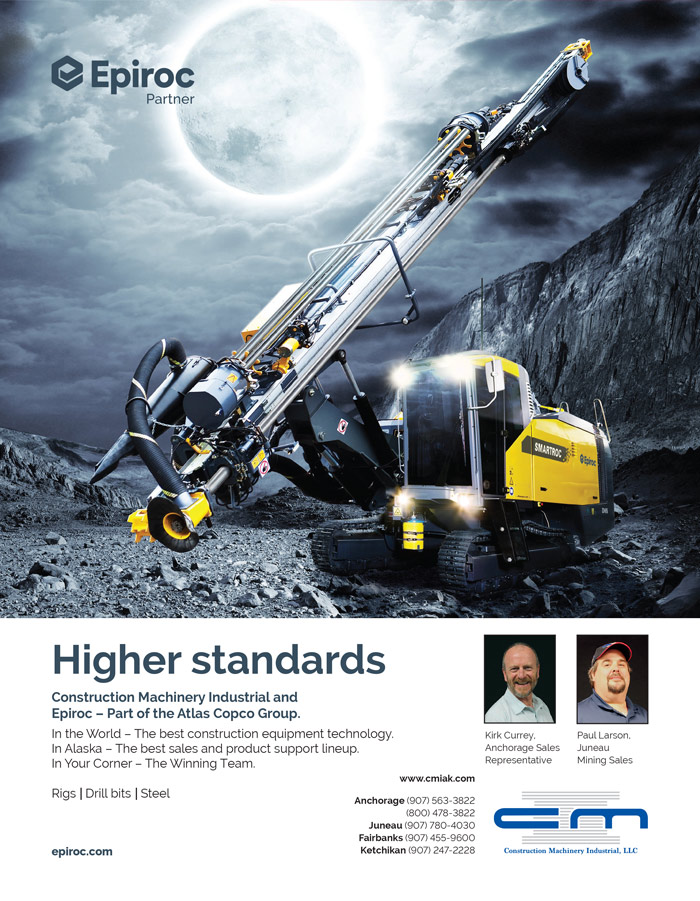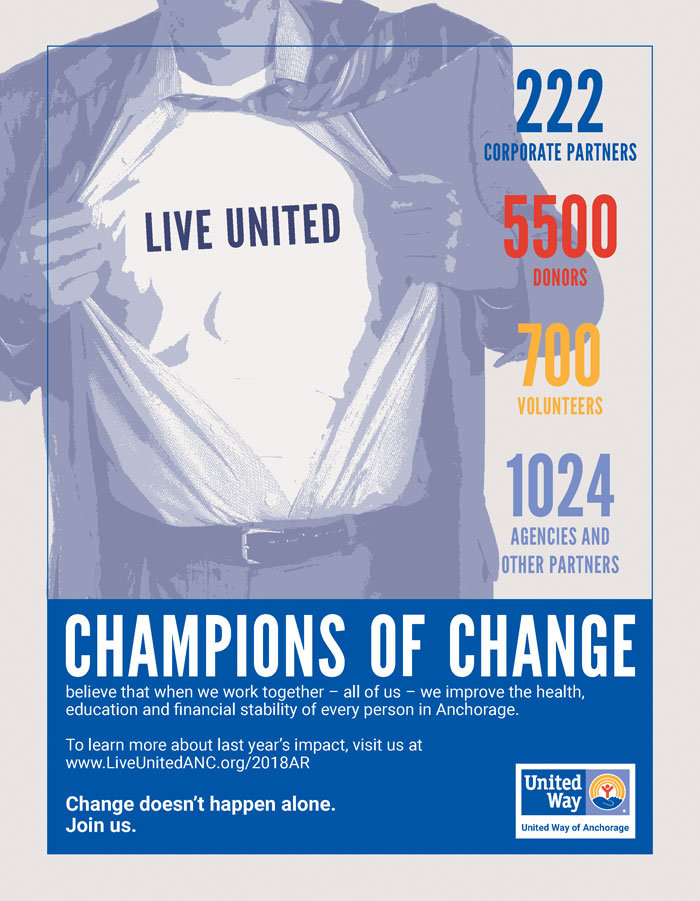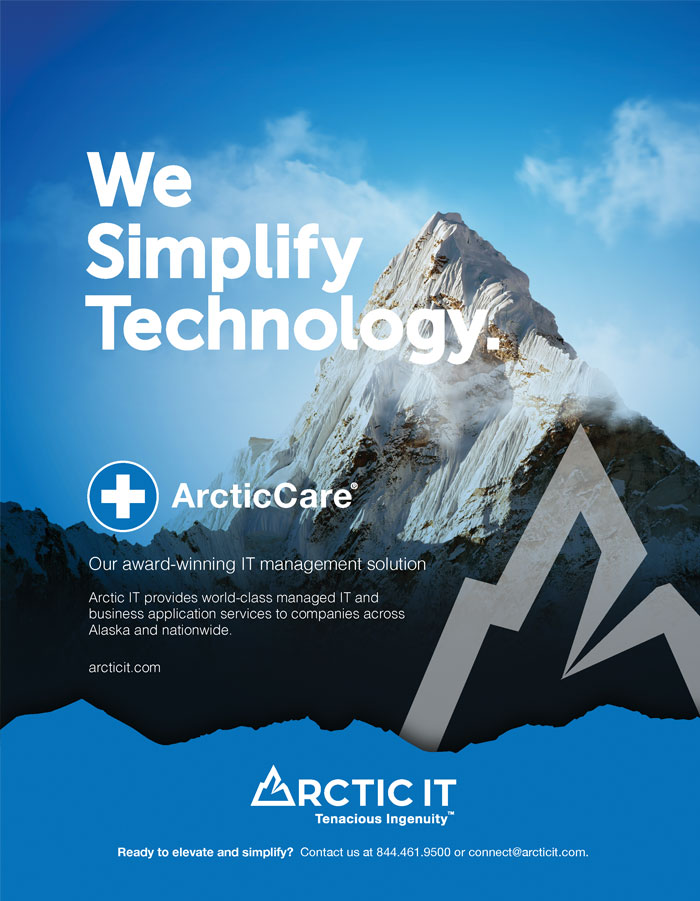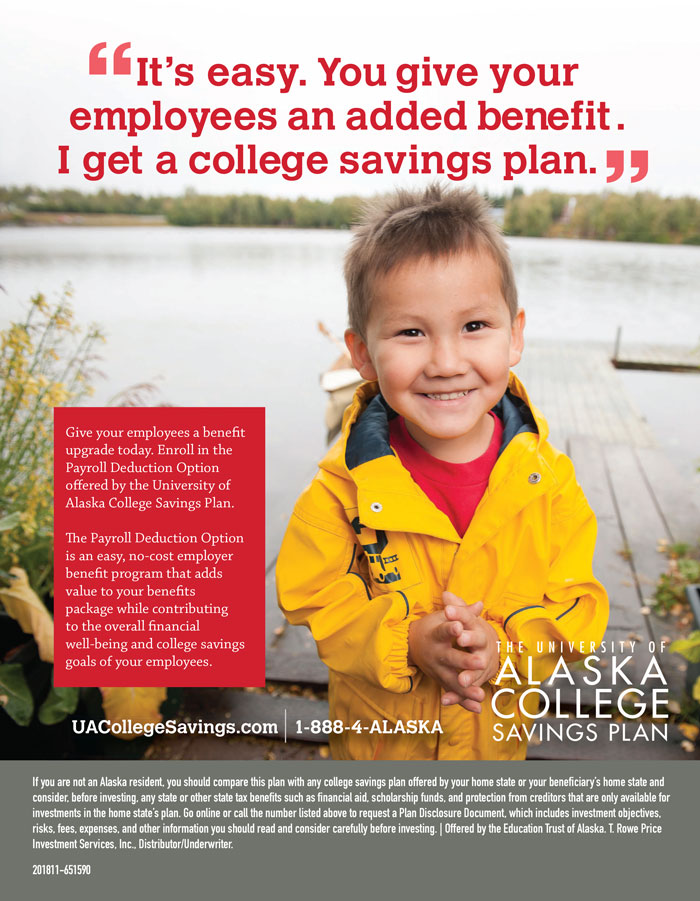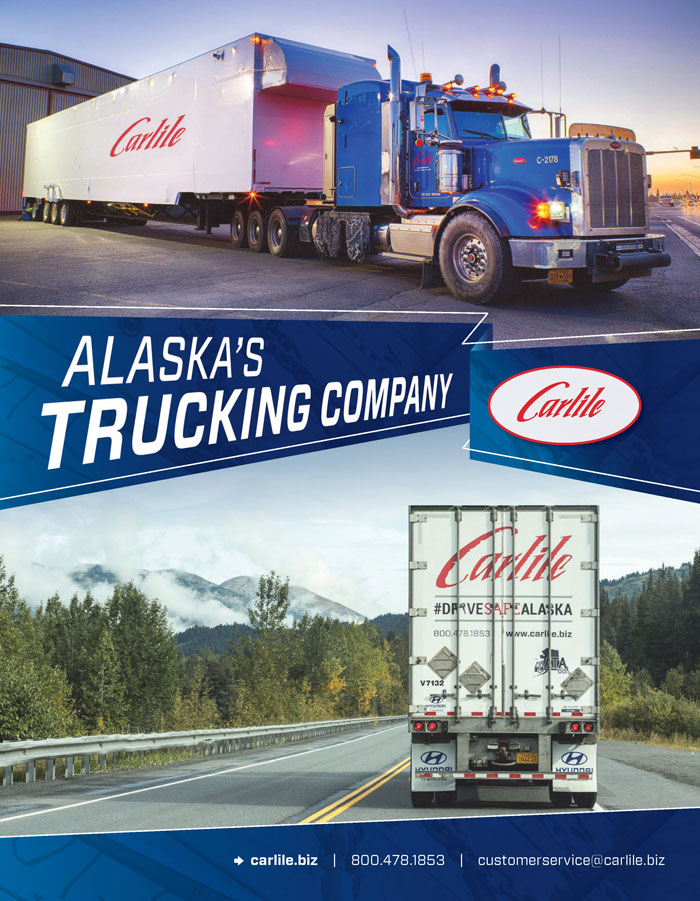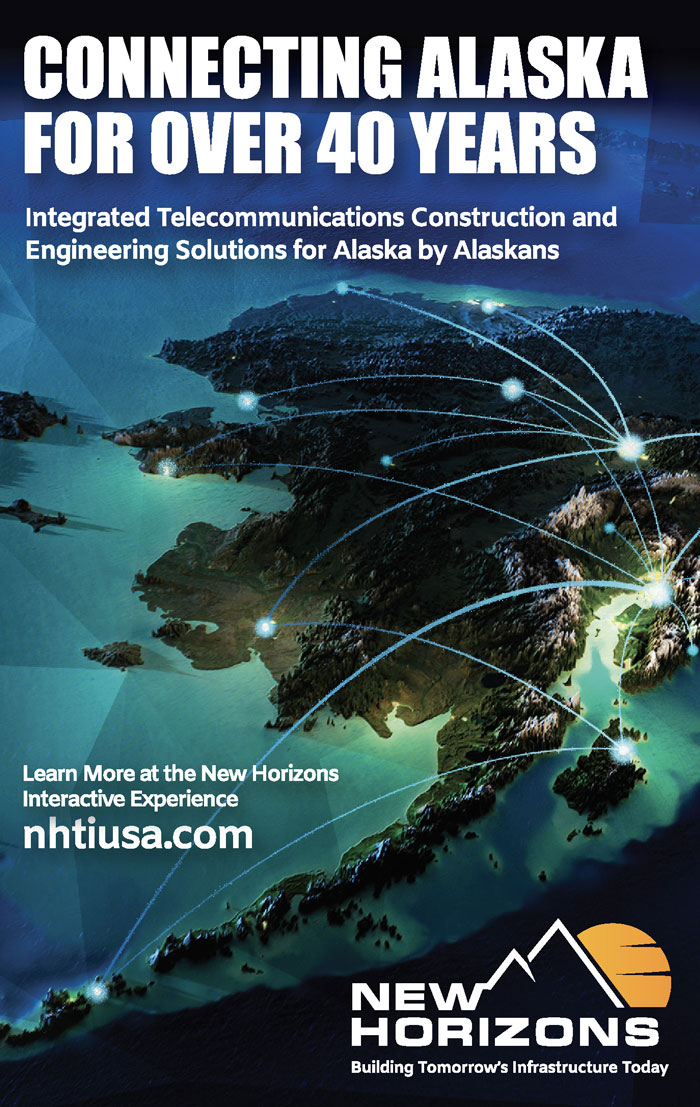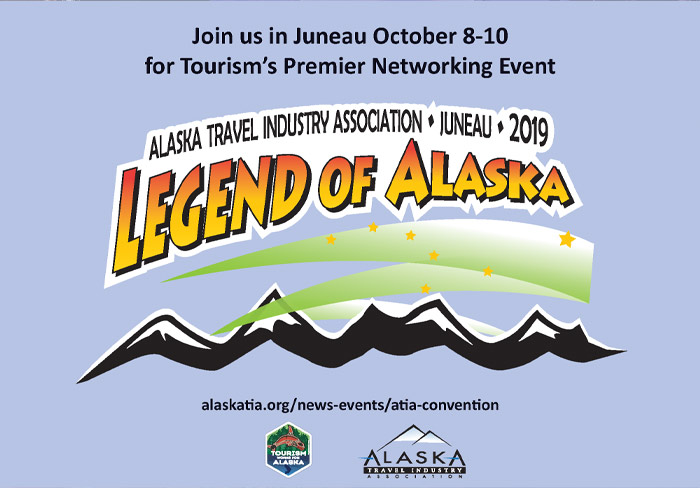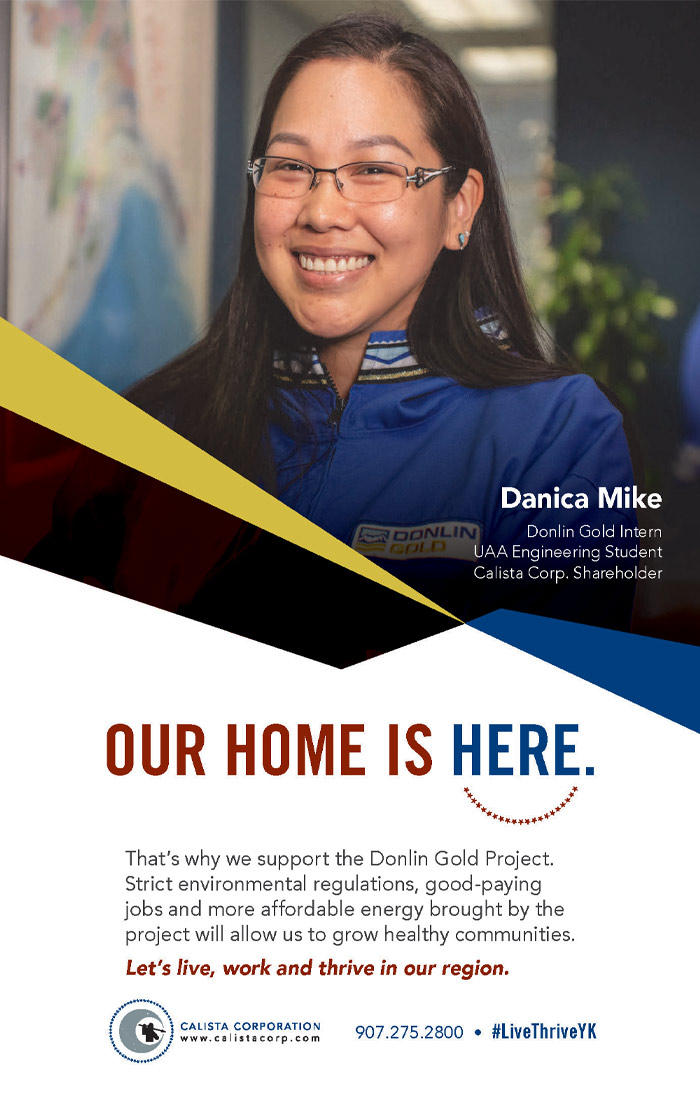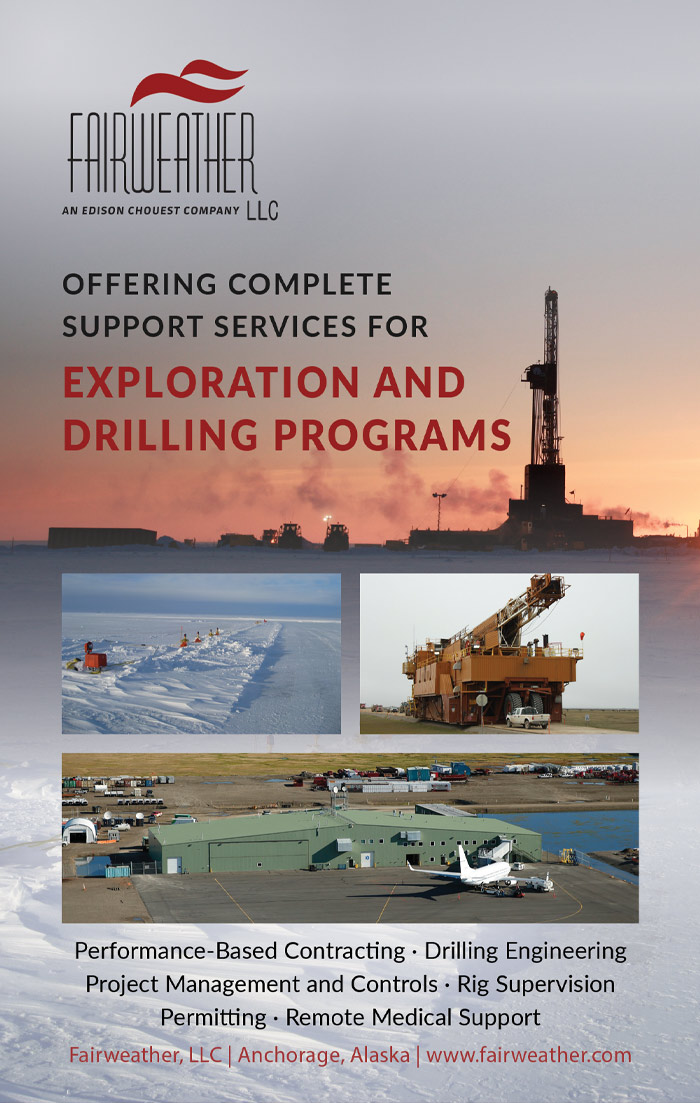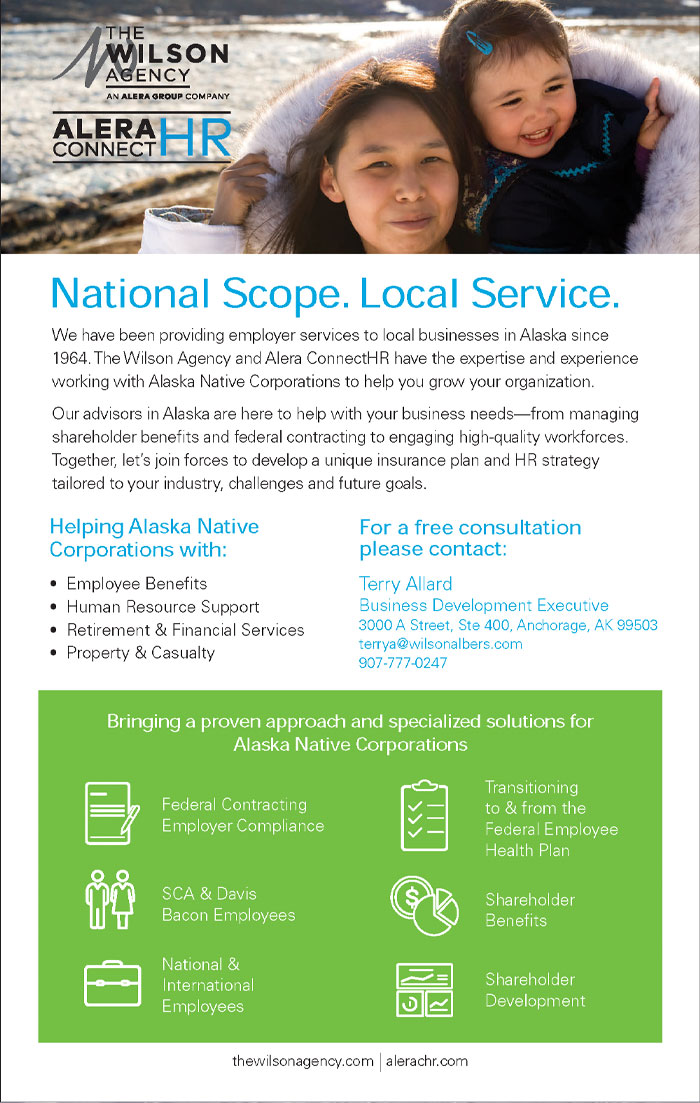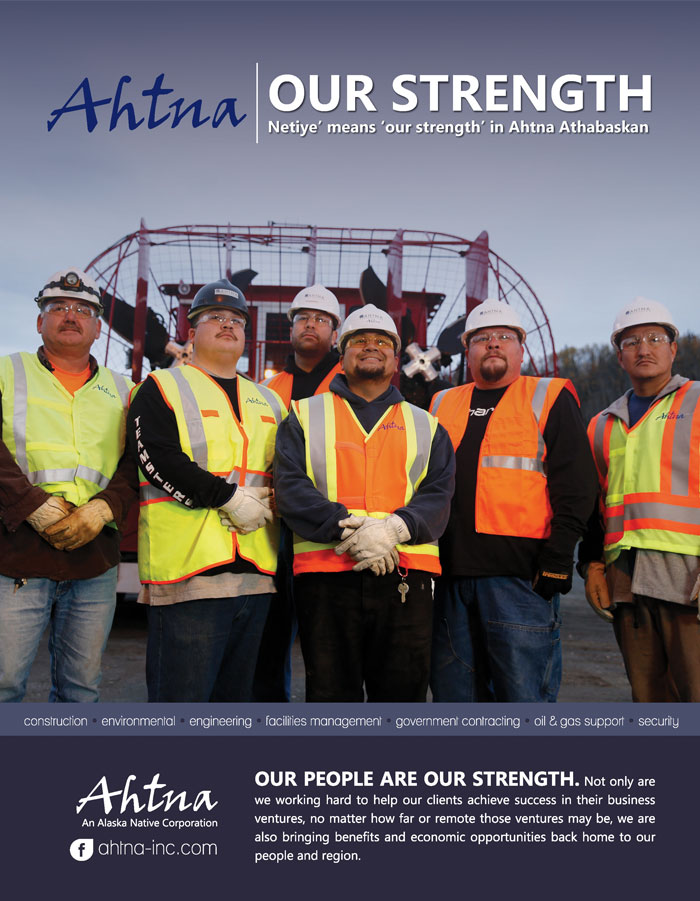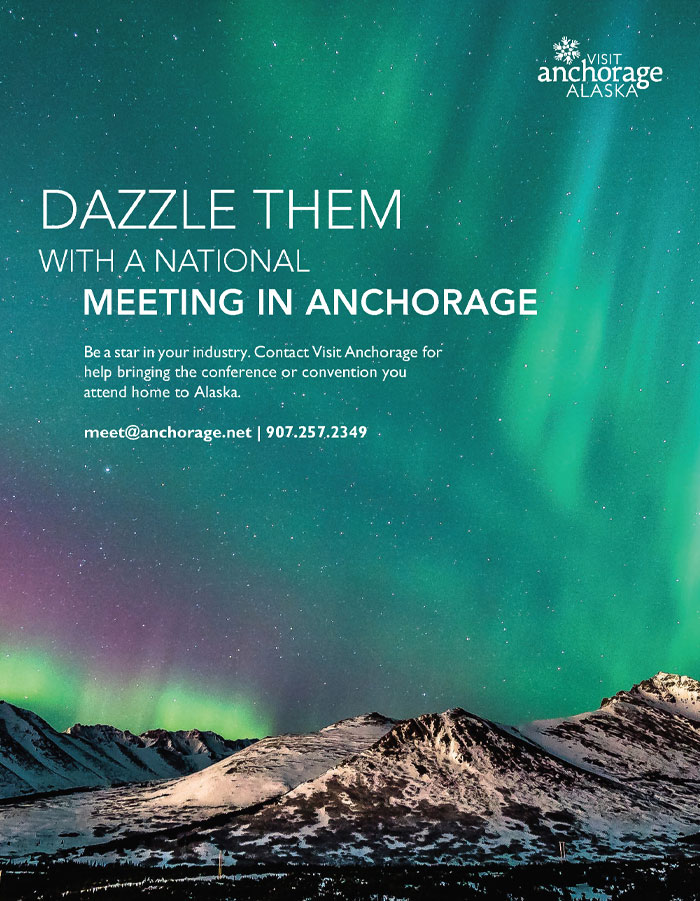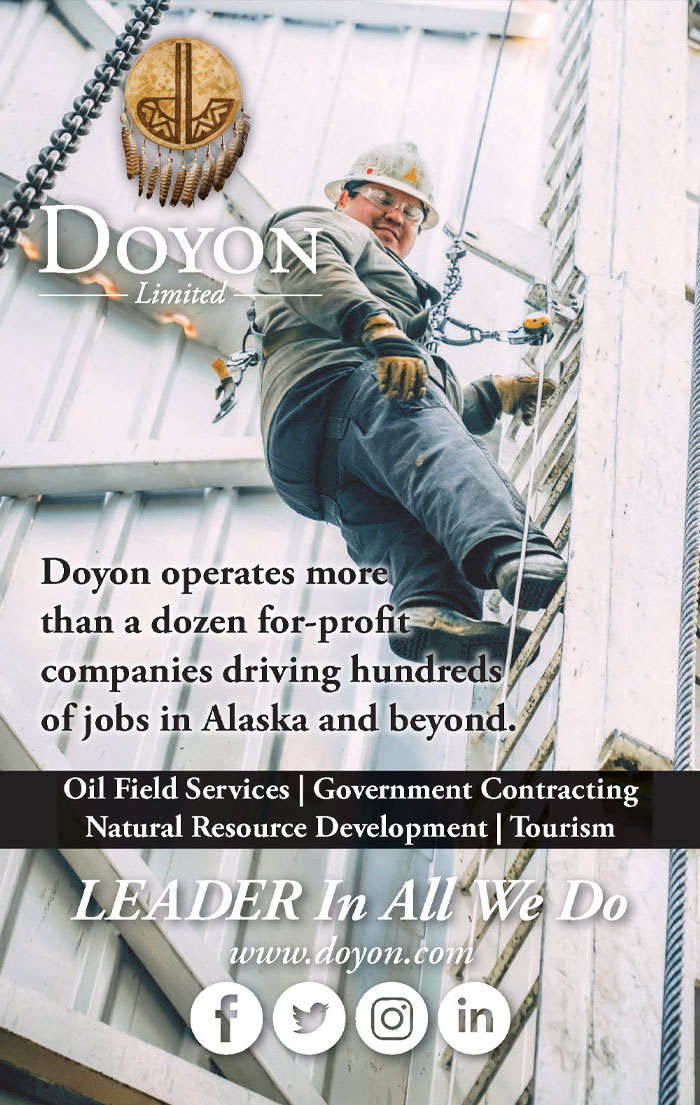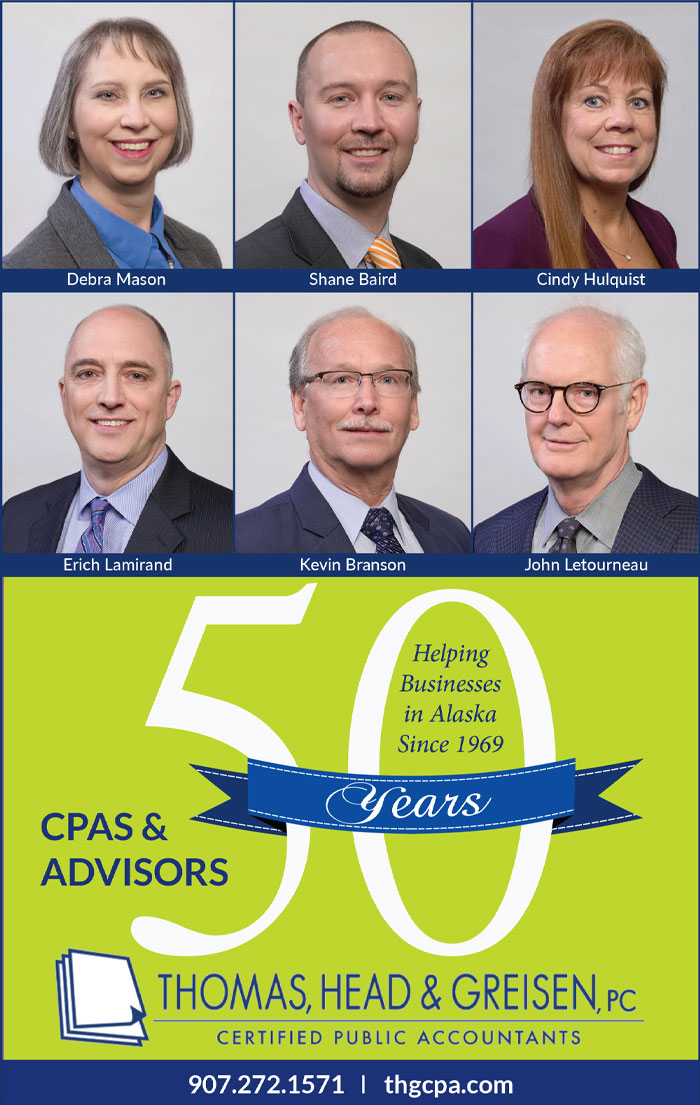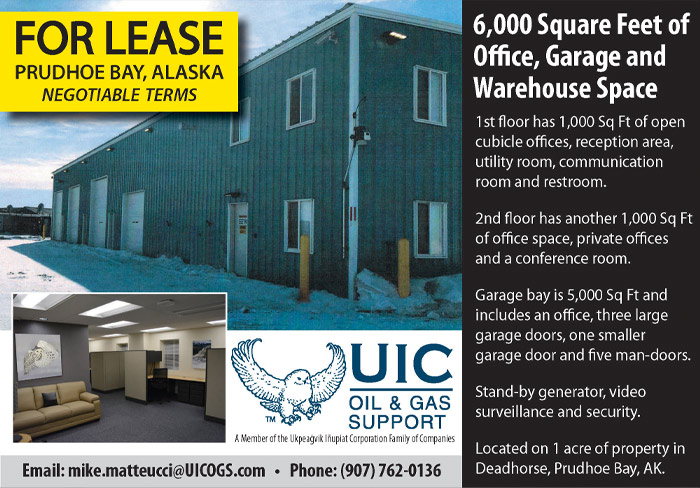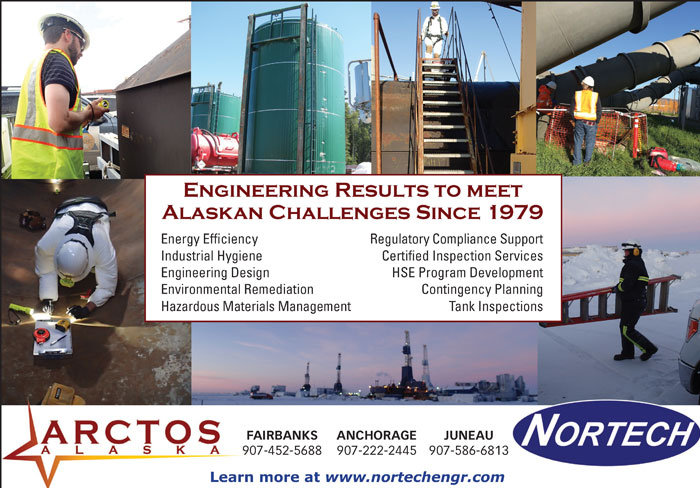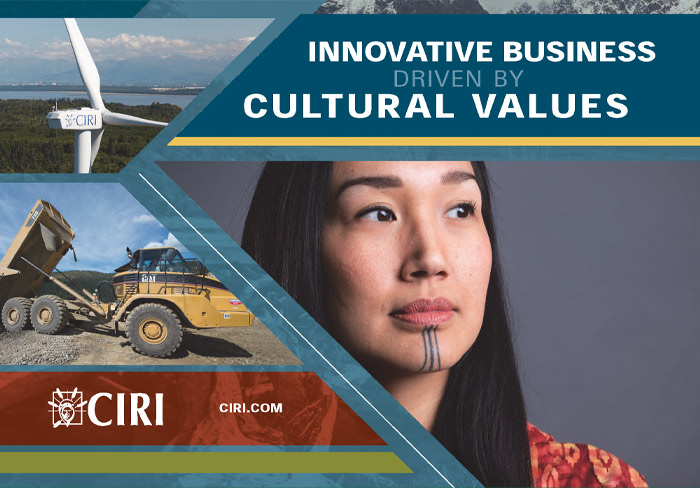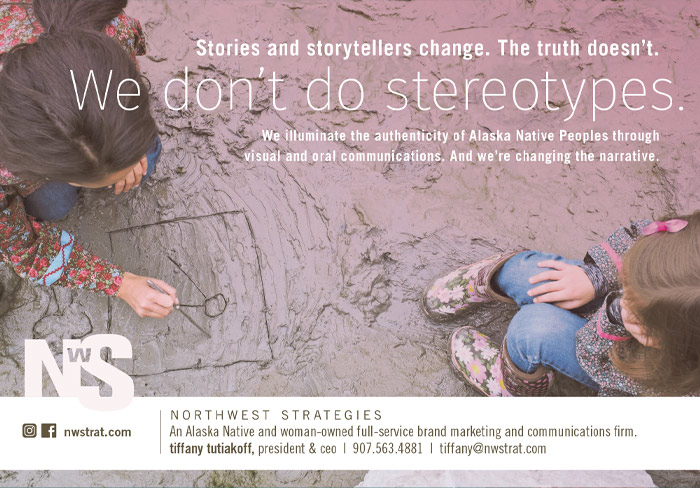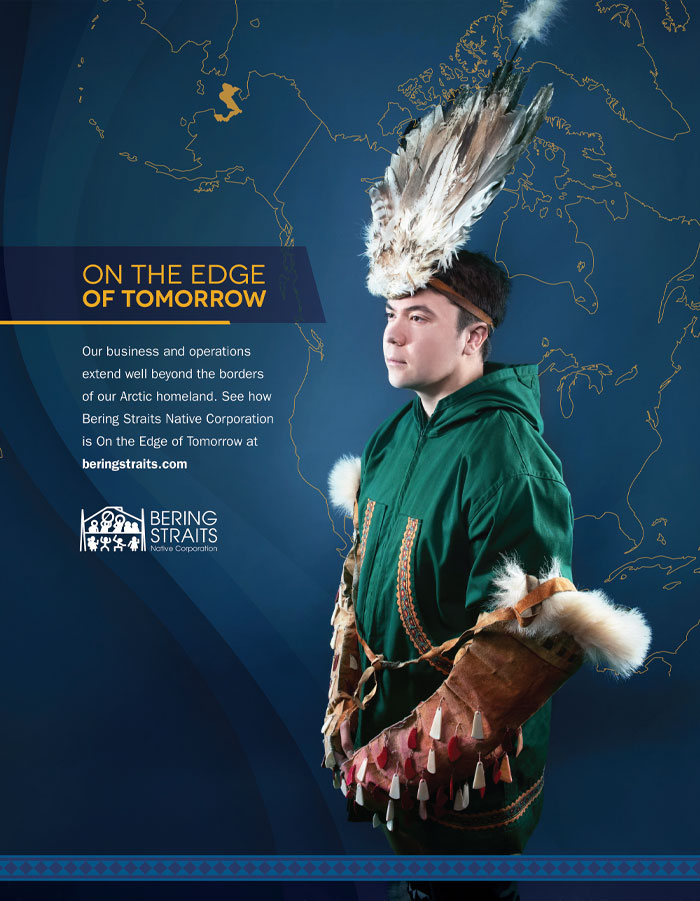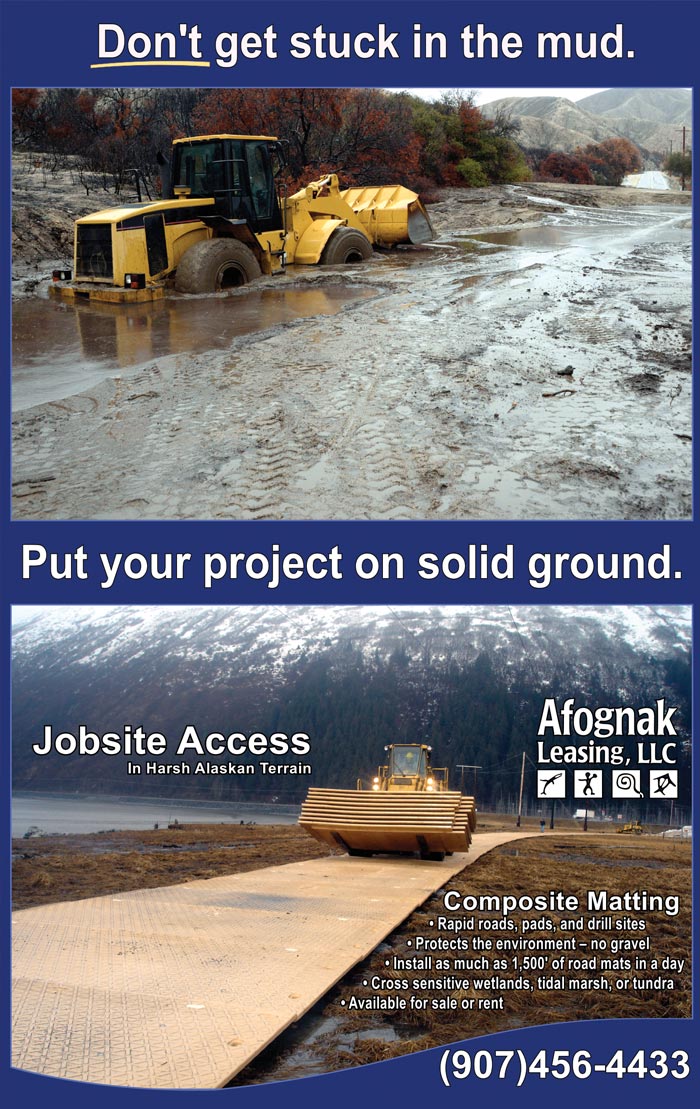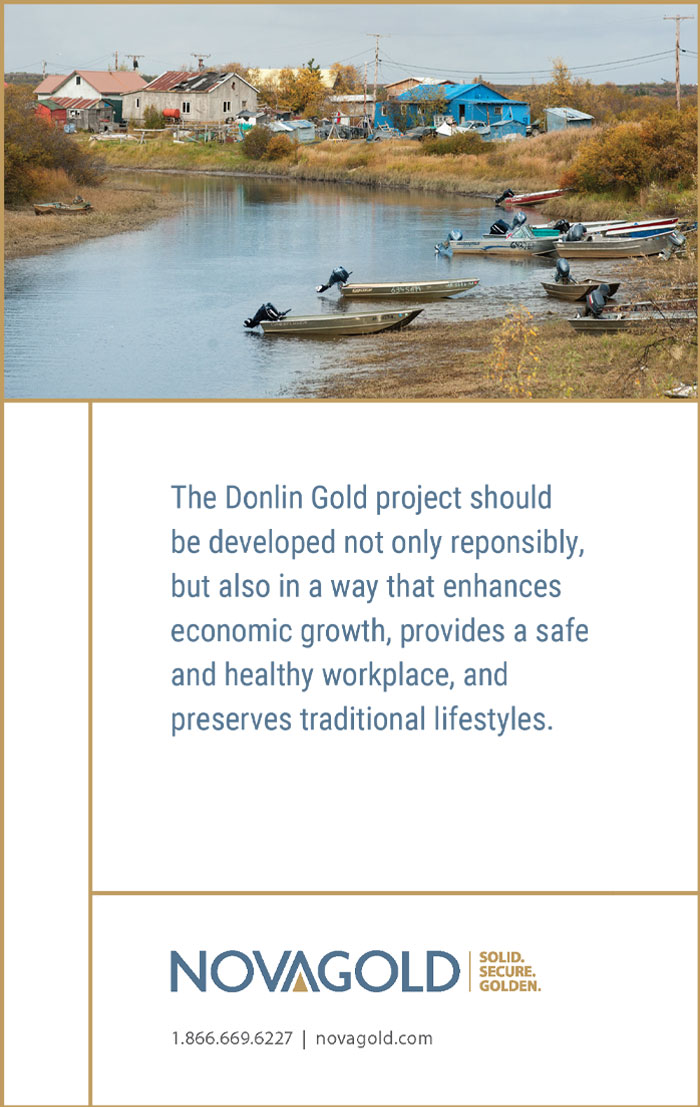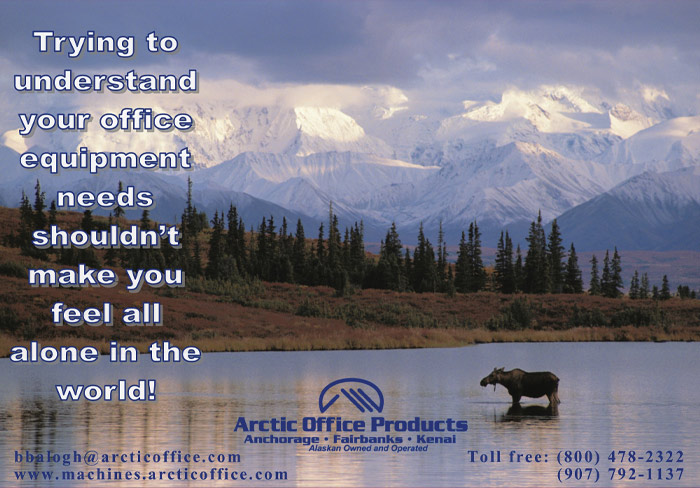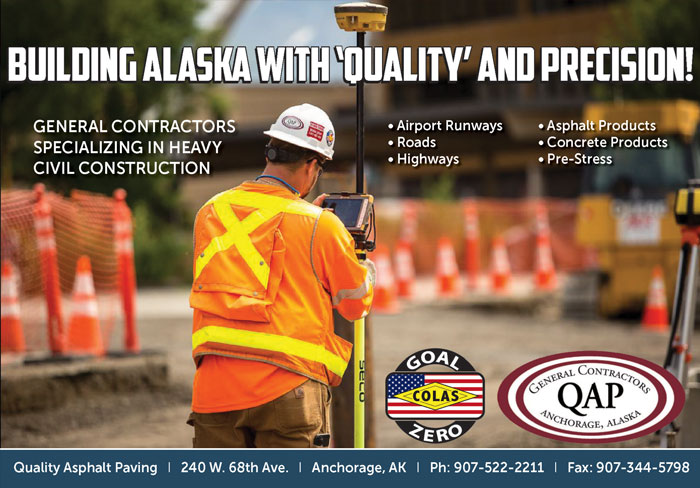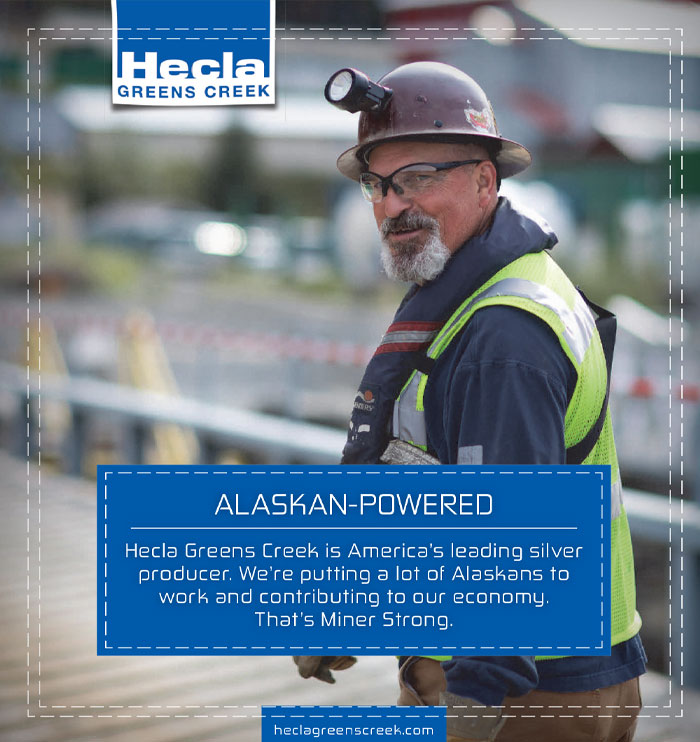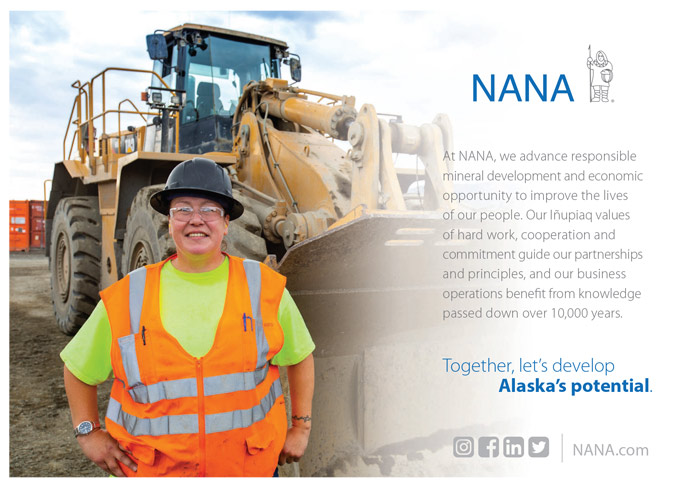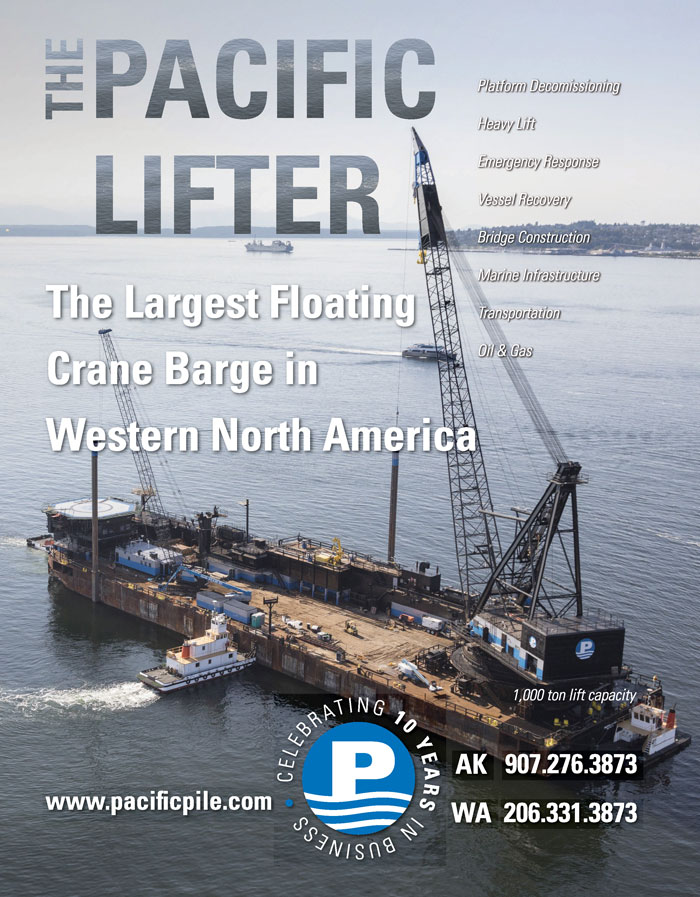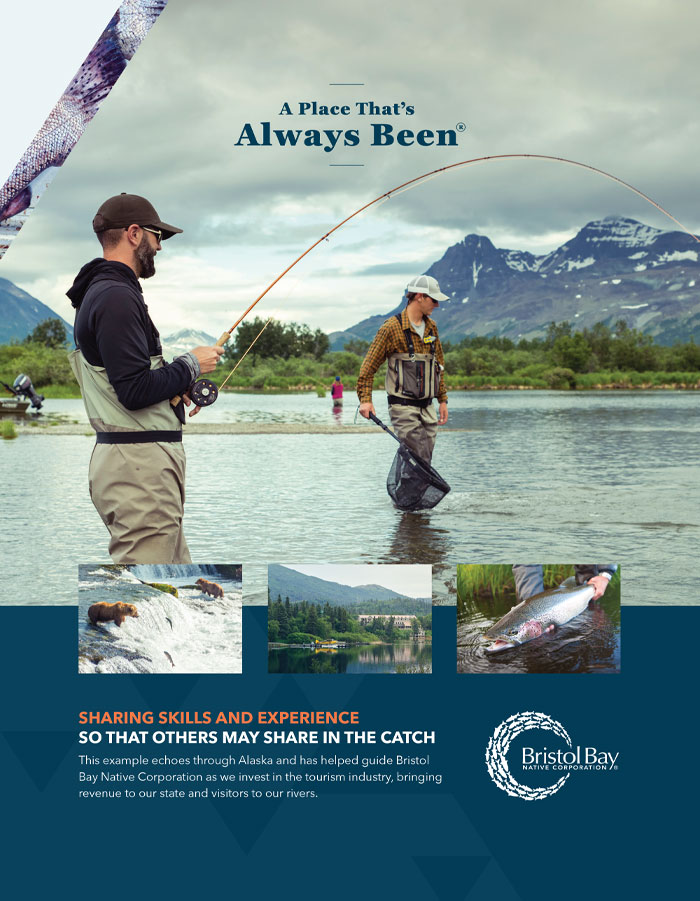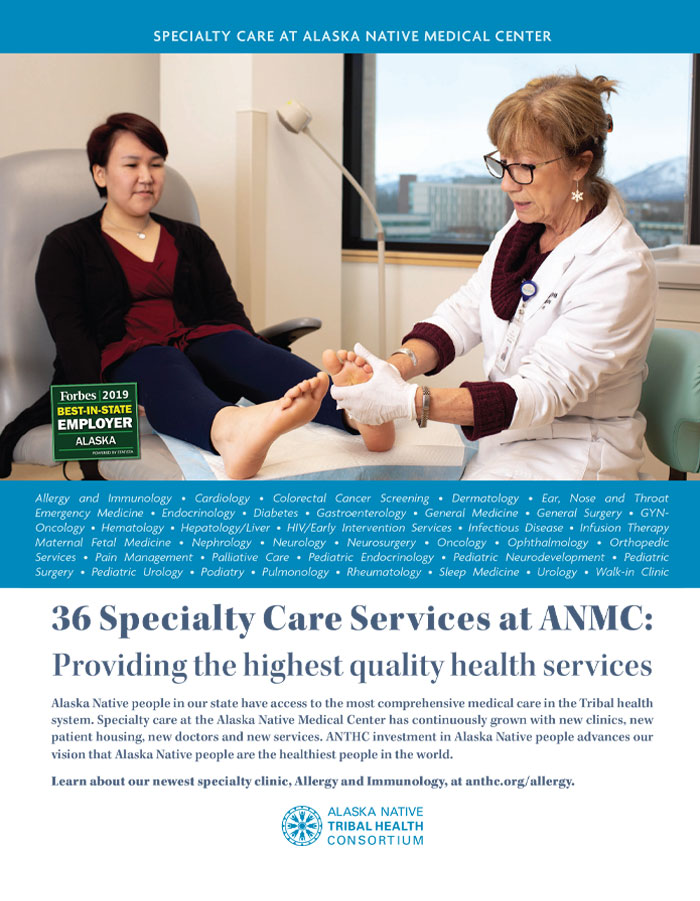Contents
Features
By Tracy Barbourr
By Sam Friedman
A Small Business Success Story
By McKibben Jackinsky
Movers and Drillers in Cook Inlet
By Isaac Stone Simonelli
Upgrades, New Construction to Improve Alaska’s Healthcare Access
By Vanessa Orr
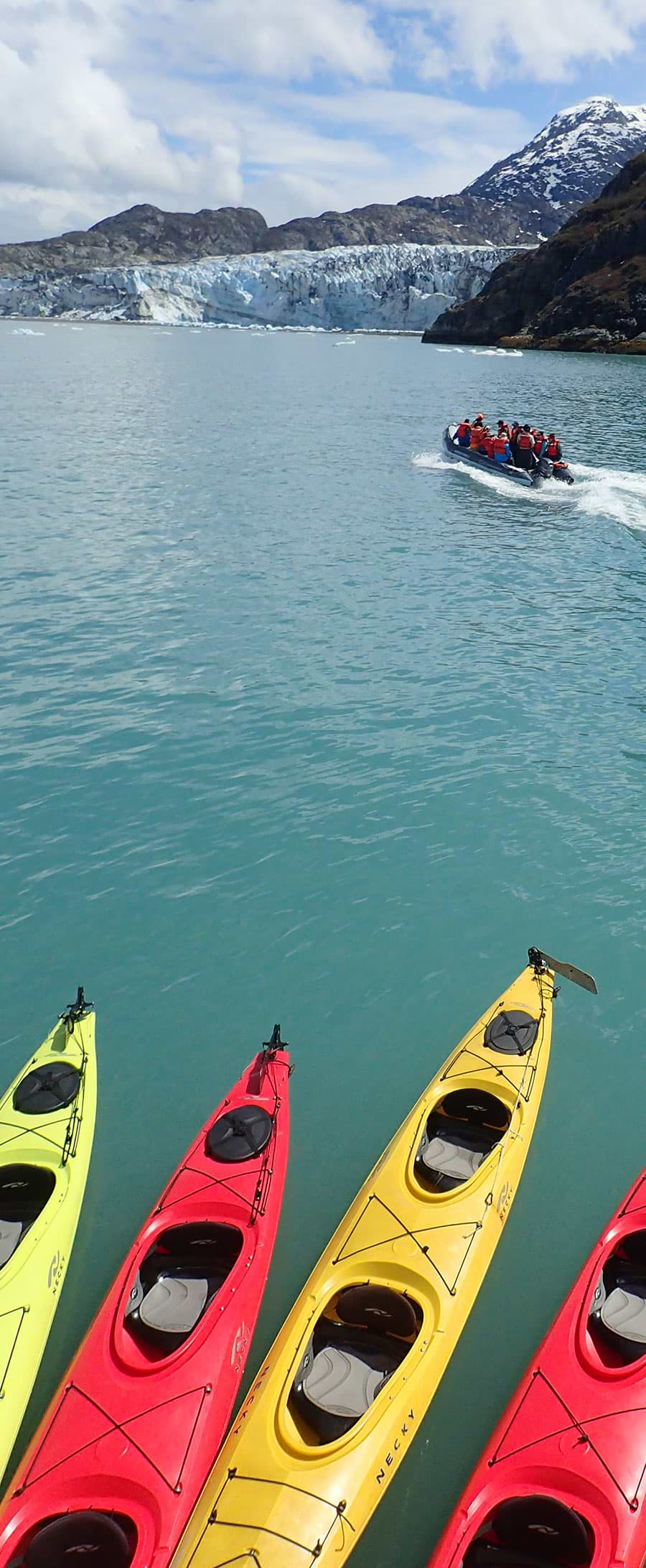
By Vanessa Orr
Out of the Mine and into the Smelter
By Brad Joyal
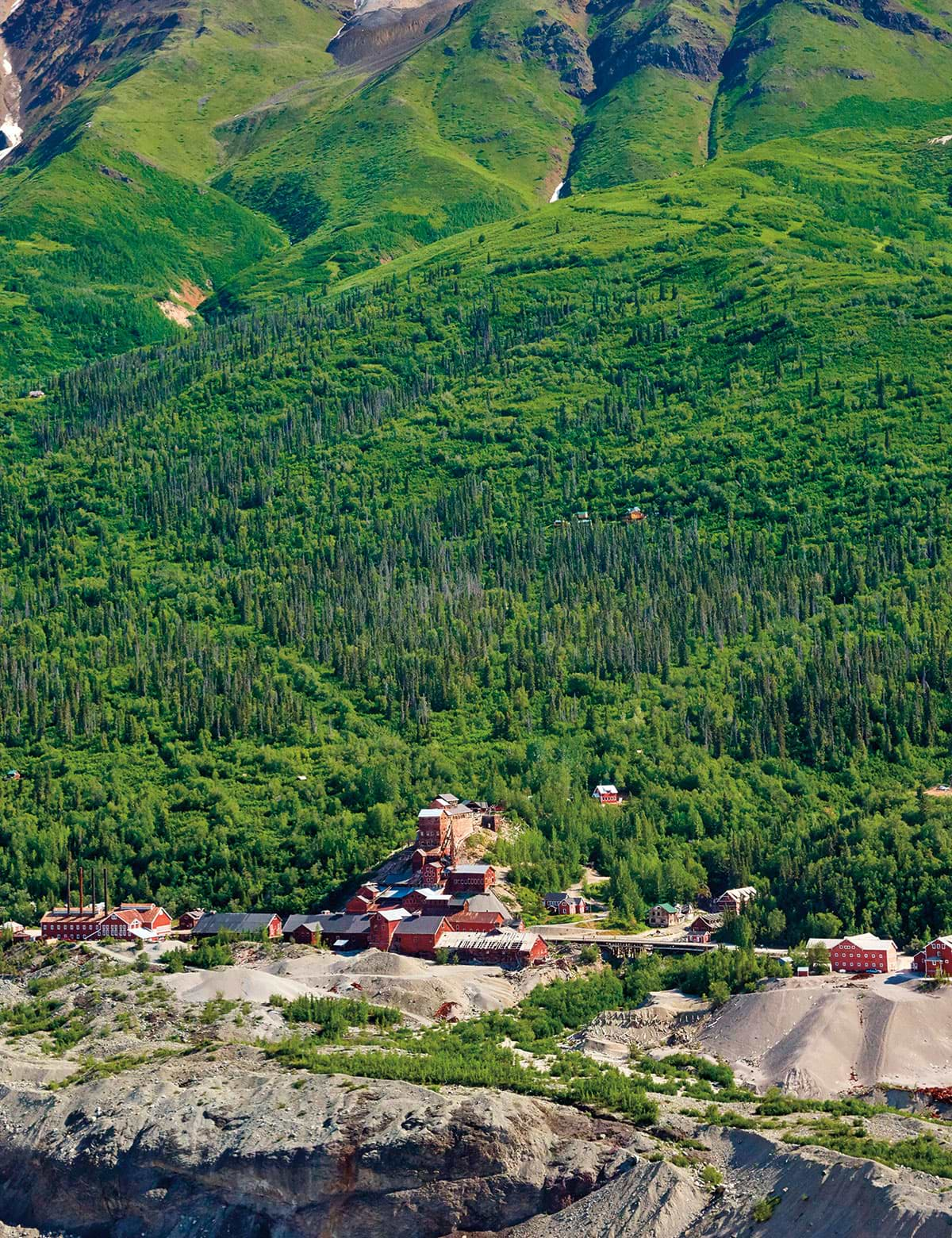
Out of the Mine and into the Smelter
By Brad Joyal
By Tracy Barbourr
By Sam Friedman
A Small Business Success Story
By McKibben Jackinsky
Movers and Drillers in Cook Inlet
By Isaac Stone Simonelli
Upgrades, New Construction to Improve Alaska’s Healthcare Access
By Vanessa Orr

By Vanessa Orr
Alaska Native Special Section
By Tasha Anderson

By Tasha Anderson
By Kathryn Mackenzie
By Sam Friedman
By Kathryn Mackenzie
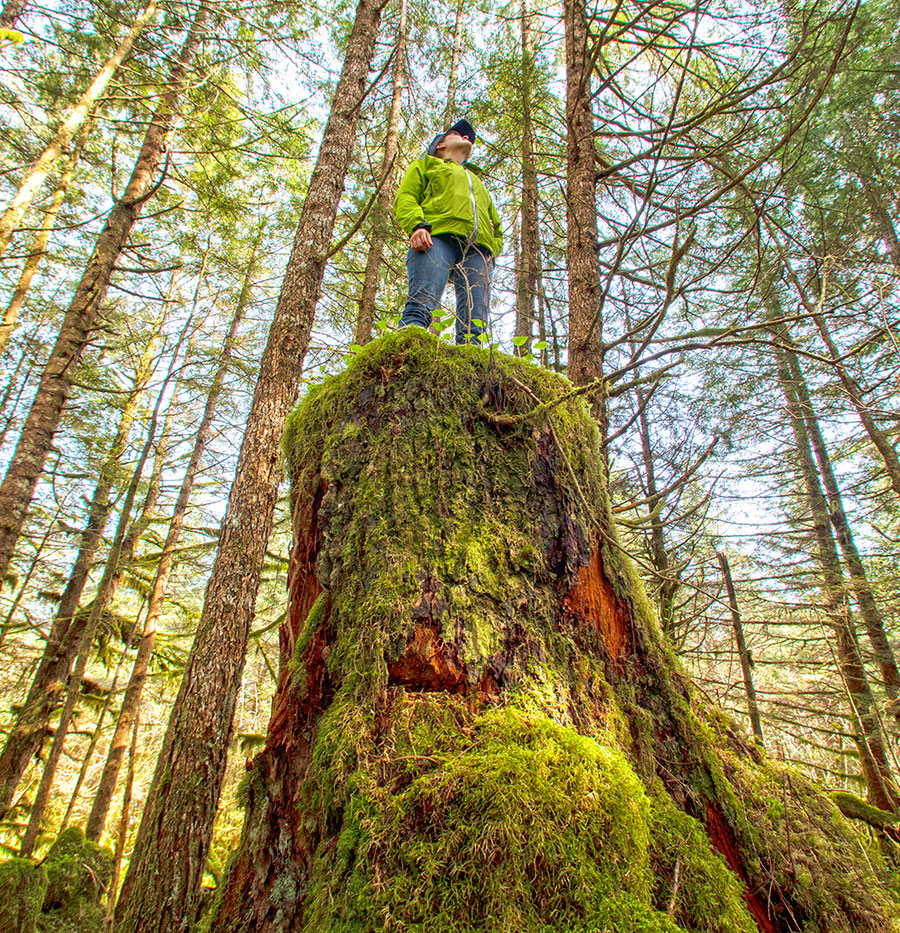
By Sam Friedman
About The Cover
Departments

Publishing Co. Anchorage, Alaska
Judy Patrick
Billie Martin
Toll Free: 1-800-770-4373
(907) 276-4373
www.akbizmag.com
Press releases: press@akbizmag.com
From the Editor
ecently we sent out a readership survey to help us better understand what you love to read in Alaska Business. We’re learning so much about your interests and the areas you’d like to see us cover more (small businesses and entrepreneurship, for example). We are heartened to learn that the great majority of you read the magazine from cover to cover every month. Thank you for your continuing support and your valuable input—we take every idea you give us seriously and are thrilled to have the opportunity to even better tailor each article to the topics that are relevant to you and the regions you’d like to see show up in the magazine more often (we hear you Southcentral). If you haven’t taken the survey yet, please do! Just visit akbizmag.com and follow the link.
One subject you’ve told us you love reading about is Alaska Native business activities, which is particularly exciting since this is the month in which we celebrate all things Alaska Native. This year we asked each of the twelve Alaska Native regional corporations a few questions about their respective business activities including their favorite programs of 2019, what initiatives their shareholders are telling them they’re excited about, and how each of their regions is unique in how it allows them to search out economic opportunities. We’re thankful to those executives who provided us with thoughtful answers for this extensive article.
This year we made a very exciting change to our Alaska Native directories by surveying not only the twelve regional corporations, but all the village corporations for which we have contact information. This change not only allows us to present you with a bigger, better, more comprehensive directory, but also gives us the opportunity to touch base with some of the smaller operations we don’t get to hear from as often.


Kathryn Mackenzie
Managing Editor, Alaska Business
Technologies
ew and evolving technology—from virtual private networks to artificial intelligence—offers diverse benefits that businesses can use to enhance their operations. But new technology also comes with inherent vulnerabilities that can jeopardize a company’s infrastructure, reputation, and other assets. However, by employing best practices and remaining vigilant, businesses can protect themselves as they evolve right along with exciting new technological applications.

Technologies
ew and evolving technology—from virtual private networks to artificial intelligence—offers diverse benefits that businesses can use to enhance their operations. But new technology also comes with inherent vulnerabilities that can jeopardize a company’s infrastructure, reputation, and other assets. However, by employing best practices and remaining vigilant, businesses can protect themselves as they evolve right along with exciting new technological applications.
© Cameron Johnson | A&C Investment Group
© Cameron Johnson | A&C Investment Group
eal estate developer Cameron Johnson is building a mixed-use walkable community amidst one of the last large pieces of undeveloped land along the Parks Highway in Wasilla.
His plans for the thirty-two acre Shoppes at Sun Mountain include the first Sonic Drive-In restaurant in Alaska, other restaurants, professional offices, a Planet Fitness gym, townhouse condominiums, and senior housing.
“There really isn’t anything else in the Valley that has that walkability factor, where you can walk out your front door and walk to the gym, go shopping, have lunch, go to the bank, and everything is within walking distance. That’s what we want to develop,” he says.
elax. Seriously, let’s do this together. Sink into your chair. Breathe in deeply for five seconds. Hold that breath for a second. Now release. Ahh… that feels good right? So does the idea that we have all just about made it through another whirlwind summer season. This also means as of August 1, we have now seen the full enactment of 2018’s House Bill 79—Omnibus Workers’ Compensation.
Now that we are all subject to House Bill 79, it is the perfect time to take stock of the changes we have had to navigate over the last year and make sure we are all still on course. We will take this one step at a time:
The Second Injury Fund is no longer open for business. Employers no longer need to make contributions to the fund and no longer benefit from payments from the fund either.
© Scott Dickerson | Bear Creek Winery and Lodging
ut Bear Creek Winery and Lodging next to other wineries in the world—castle-neighboring wineries in Alsace, France; Tuscany wineries scattered from seashore to rolling countryside; the California wineries of Sonoma County—and this family-run Alaska business stands tall.
It has an award-winning product, can claim bragging rights for using Alaska fruits and berries, offers overnight accommodations designed with Alaskans in mind, has a picture-perfect setting near the shores of Kachemak Bay, has roots that sink deep into its surrounding community, and is a multi-generational enterprise.
Using the kitchen in the family’s home a few miles east of Homer, Bill Fry began trying his hand at winemaking in the 1990s. Positive reactions from friends to whom Bill gave bottles of his wine as gifts for birthdays, holidays, and special occasions encouraged the budding vintner. It wasn’t long before the kitchen became too small for his growing interest and Bill was forced to find a bigger space to set up shop: the garage. Blueberries, raspberries, rhubarb—just name it and Bill found a way to incorporate it in his wine-making experiments.
© Matt Hage | State of Alaska
© Matt Hage | State of Alaska
laska is a wonderful place to live year-round, but most people who choose to visit come during the warmer summer months. While this is a big boost to the economy, some companies are encouraging travelers to come earlier and stay longer, creating more lucrative shoulder seasons in April, May, September, and October.
The Alaska Travel Industry Association (ATIA) promotes the state as a year-round destination, and that includes attracting visitors during the shoulder seasons. “If we can get people to visit at this time of year, it really benefits our communities and businesses,” explains Sarah Leonard, ATIA president and CEO. “Businesses can stay open longer, which makes them available to residents as well as visitors. And if the Alaska tourism industry strengthens our year-round visitor numbers, it also allows these businesses to hire more residents, generating more economic activity for these companies and for Alaska.”
Why Visit during the Shoulder Season?
There are many reasons why visitors might want to come to Alaska when it’s not teeming with tourists—especially if the point of their vacation is to get away from it all. Restaurants and shops are far less crowded. And there’s less competition when it comes to seeing Alaska in its natural state.
UnCruise Adventures has made a point of marketing to the shoulder season traveler. Their “Alaska Awakening” campaign, launched two years ago, invites visitors to enjoy a more intimate experience in the great outdoors.
Since they were established as corporations in the early 1970s, the twelve Alaska Native Regional corporations have worked tirelessly to uplift their respective regions, their shareholders, and the state’s economy as a whole. All together they reported more than $10.5 billion in revenue last year—revenue that creates opportunities; protects their lands, culture, and resources; and provides investment opportunities for the entire state and, more importantly, their shareholders.
This year Alaska Business asked each corporation’s top executives to share a little about their business, new initiatives, and what makes them unique in an already rarified group. We are grateful to every person who took the time out his or her (very) busy schedule to offer this valuable insight into the past, present, and future of the regional corporations.
In no particular order, we present a snapshot of the twelve Alaska Native Regional Corporations.
he relatively short history of the corporations formed by the Alaska Native Claims Settlement Act is one of determined perseverance. The corporations established in the early 1970s were charged with the responsibility of creating economic opportunity to support their region and shareholders, using surface and/or subsurface real estate and money conveyed as part of the settlement. But experience participating in the corporate sphere isn’t something one can transfer via signed agreement, and many corporations struggled in their early years.
For Bering Straits Native Corporation (BSNC), one of the corporation’s most challenging years was 1986, when it filed for Chapter 11 bankruptcy protection. According to a four-part BSNC Land Series by Vice President of Media and External Affairs Matt Ganley, “BSNC made errors, and in some cases was the recipient of unscrupulous or inadequate investment and business advice. Companies were purchased and investments made with the long-term goal of developing a business portfolio that would enhance the original ANCSA settlement. These often proved to be companies that looked promising but had little value as long-range growth strategies. As the late Charlie Johnson once said, ‘We bought a tire company with no tires and a construction company with no equipment.’”
What followed was a “series of complex agreements designed to protect BSNC’s land base, repay the village corporations for the lost settlement funds, and bring BSNC back from bankruptcy.”
elcome to the 2019 Alaska Native Corporations Directory. This year we sent surveys to both the regional and village corporations in order to provide an even more comprehensive listing of Alaska’s native organizations. We appreciate all of the time and effort put into gathering and reporting this data to us, and we look forward to this list becoming even more robust in years to come. For more directory content and information, please visit akbizmag.com/lists/.
Afognak Native Corporation, Alutiiq, and their subsidiaries provide an exceptional track record of services in the government and commercial sectors worldwide, including: leasing; construction; timber; engineering; security; logistics, operations, and maintenance; oilfield; and youth services.
Top Executive: Greg Hambright, President/CEO
Worldwide/Alaska Employees: 4,546/151
Acreage: 248,000
Number of Shareholders: 1,185
Subsidiaries: Shields Point, Alutiiq Advanced Security Solutions, Alutiiq Construction Services, Alutiiq Education & Training, Alutiiq Essential Services Alutiiq General Contractors, Alutiiq International Solutions, Alutiiq Professional Services, Alutiiq Security & Technology, Alutiiq Commercial Enterprises, Alutiiq 3SG, Alutiiq Technical Services, Alutiiq Pacific, Alutiiq Diversified Services, Alutiiq Management Services, Alutiiq Manufacturing Contractors, Alutiiq-Mele, Alutiiq Professional Training, Alutiiq Global Solutions, Afognak Near Island, Afognak Arctic Development, Afognak C Street, Marka Bay, Alutiiq Business Services, Alutiiq Logistics & Maintenance Services, Alutiiq Solutions, Alcyon, Inc., Alutiiq Information Management, Alutiiq Career Ventures, Afognak Leasing, McCallie Associates, Inc., Oxbow Data Management Systems, Alutiiq Leasing Company, Alutiiq Employee Leasing, Alutiiq Professional Consulting, Alutiiq, Red Peak Technical Services
300 Alimaq Dr. Kodiak, AK 99615
907-486-6014
afognak.com
alutiiq.com
Ahtna, Inc.
Ahtna’s principle activities include construction, engineering, environmental, facilities management, surveying, security, military training, janitorial, healthcare and medical records management, government contracting, land management and resource development, and oil and gas pipeline services.
Top Executive: Michelle Anderson, President
Worldwide/Alaska Employees: 1,101/292
Acreage: 1.5 million
Number of Shareholders: 2,065
Subsidiaries: Ahtna Development Corp., Ahtna Facility Services, Inc., Ahtna Support & Training Services, Ahtna Government Services Corp., Ahtna Construction & Primary Products Company, Ahtna Design Build, Inc., Ahtna Professional Services, Inc., Ahtna Environmental, Inc., Ahtna Technologies, Inc., AKHI, Ahtna Global, Ahtna Logistics, Tolsona Oil & Gas Exploration, Ahtna Engineering Services, AAA Valley Gravel, Ahtna Netiye’, Ahtna Infrastructure & Technologies, Ahtna Integrated Services, Ahtna Marine & Construction Company, Ahtna Solution
PO Box 649, Glennallen, AK 99588
907-822-3476
ahtna-inc.com
news@ahtna.net
facebook.com/Ahtna.Inc
twitter.com/ahtnainc
linkedin.com/company/ahtna-inc
Akhiok-Kaguyak, Inc. (AKI) is an Alaska Native Village Corporation specializing in commercial real estate, private equity, government products and services, tourism, and lands management.
Top Executive: Michael Bradshaw, President/CEO
Worldwide/Alaska Employees: 11/3
Acreage: 77,000
Number of Shareholders: 278
1400 W. Benson Blvd. #425, Anchorage, AK 99503
907-258-0604
aki-kodiak.com
info@aki-kodiak.com
linkedin.com/company/akhiok-kaguyak-inc
here’s money to be made in promising to reduce your company’s environmental footprint by cutting down fewer trees. And Alaska’s largest landowners are getting behind this new type of business in a big way.
Alaska is now the largest producer of forestry carbon offsets for California’s greenhouse gas cap and trade program, despite qualifying to sell the credits years behind the contiguous United States. Thus far, four Alaska Native regional corporations and eight village corporations have received carbon offset credits through the program or have started the process of registering credits.
At current prices of about $13 per offset credit, the carbon offsets registered in Alaska are worth about $370 million. And that’s just the initial carbon credits awarded for these projects. As forests continue to grow, they will produce a smaller number of new credits equal to the value of the carbon dioxide stored in the new growth compared to similar forestland outside the project.
The new market created by California’s greenhouse gas rules opened to Alaska in 2015. It’s scheduled to partially close in 2021, with a new regulatory change that will cut demand for forestry credits produced in Alaska by 75 percent.
ilcorp Energy continues to dominate the oil exploration scene in Cook Inlet—it’s the only company to put in a bid on the State of Alaska’s annual Cook Inlet basin oil and gas lease sale for the third consecutive year.
The Houston-based company that specializes in mature fields spent $190,350 on three lease tracts totaling 10,286 acres earlier this year, according to the Alaska Department of Natural Resources (DNR), Division of Oil and Gas.
“We are pleased to see bid activity in the Cook Inlet lease sale,” DNR Deputy Commissioner Sara Longan said in a prepared statement earlier this year. “We recognize the focus of investment has been on the North Slope in recent years. Nevertheless, significant investment is made to sustain current Cook Inlet production, while exploration activities continue to inform and support future development.”
ealthcare construction in Alaska is influenced by many different factors, including an aging population; the need for specialized services such as mental health and addiction treatment; technological advancements; and requirements to update or replace facilities and equipment in order to meet state and federal regulations. Yet while it’s important to invest in expanding, renovating, or even building brand new facilities, healthcare systems must at the same time keep a very tight grip on expenses, especially in this time of economic uncertainty.


ining has long been a key fixture of Alaska’s economy. On a small scale, people flock to the 49th state to tour different operations. Kennecott Mine was once a booming copper mining site and is now a National Historic Landmark, attracting tourists eager to visit the ghost town and get a feel of the Gold Rush era it once dominated. Gold Dredge No. 8 provides tourists with an opportunity to pan for gold while learning more about the Interior’s mining history. Although some tourists might visit Alaska to learn about the state’s mining past, the industry remains at the center of the state’s economy today.
The Alaska mining industry includes exploration, mine development, and production, and it continues to provide Alaskans with thousands of jobs while generating millions of dollars of personal income. Alaska’s six large operating mines—Fort Knox, Greens Creek, Kensington, Red Dog, Usibelli, and Pogo—provided 2,400 full-time jobs of the state’s nearly 4,500 mining industry jobs in 2018. In all, there were 9,200 direct and indirect mining industry jobs in 2018, and those jobs dished out $715 million in payroll. Development spending in 2018 was $170 million and the export value from Alaska production was $1.8 billion.
Mineral exports accounted for 36 percent of Alaska’s export total in 2017, and all signs point to mined commodities staying one of the state’s leading exports for years to come.
Alaska Trends -Mine,Mine,Mine
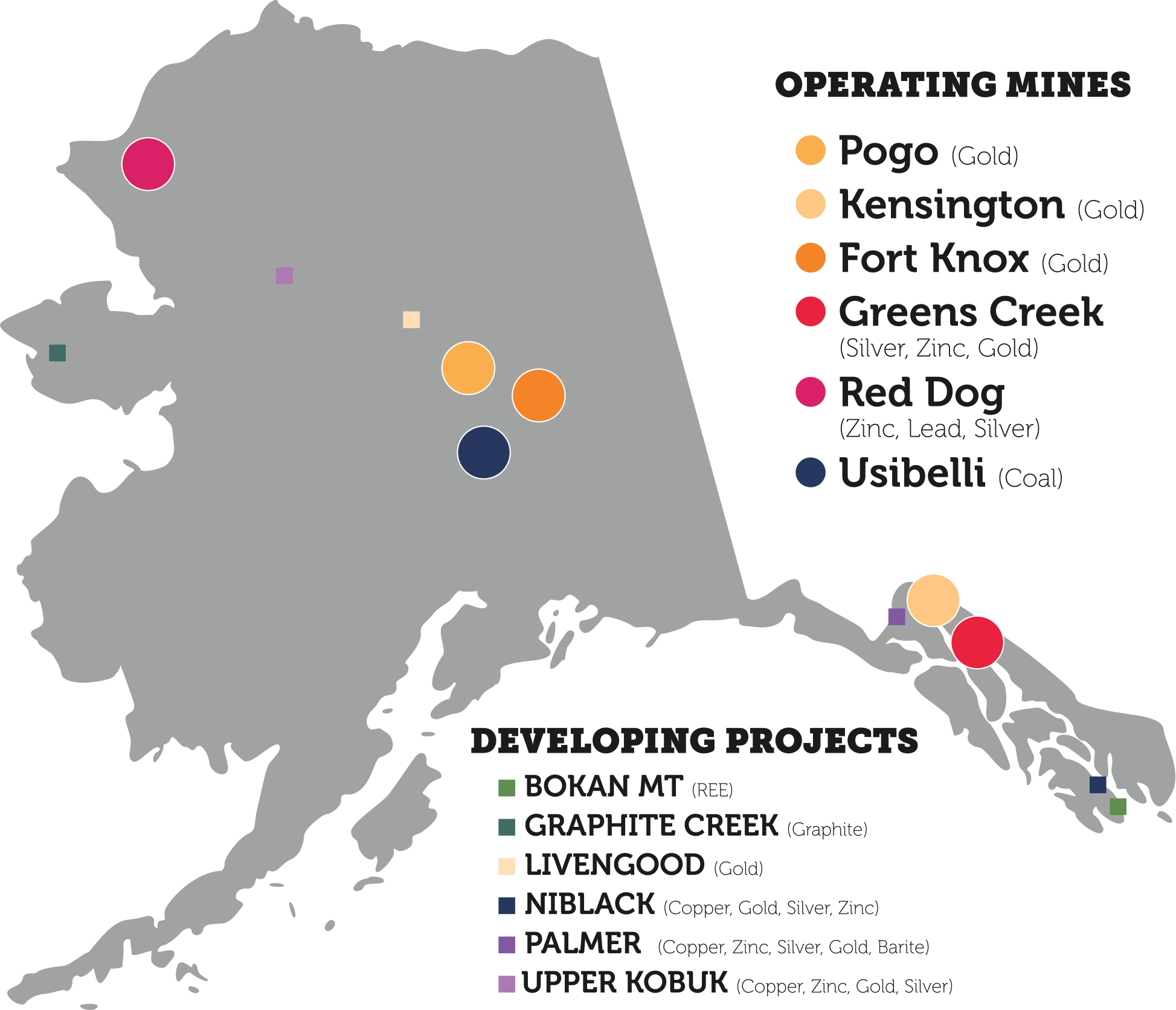


Kensington is 2nd largest private sector employer in Southeast Alaska in terms of payroll; over $36 million in 2017.
Pogo paid approximately $44 million in wages.

anchoragemuseum.org
The Alaska Veterans Museum’s mission is to “create a museum for the inspiration, remembrance and preservation of the memory of veterans and of their sacrifices for America’s freedom.”
alaskaveterans.org

21
equinoxmarathon.org
1-2
This festival is hosted by Alyeska Resort and is a celebration of the fiddlehead fern season and summer music in the mountains; the family-oriented, outdoor event features live music, local arts and crafts booths, beer and wine garden, cooking demos, 5K Fun Run, and children’s activities. Alyeska Resort’s talented chefs host hands-on demonstrations and share techniques for cooking with fiddleheads. alyeskaresort.com

7
7
14
20-21
27-28
Oktoberfest at Alyeska Resort
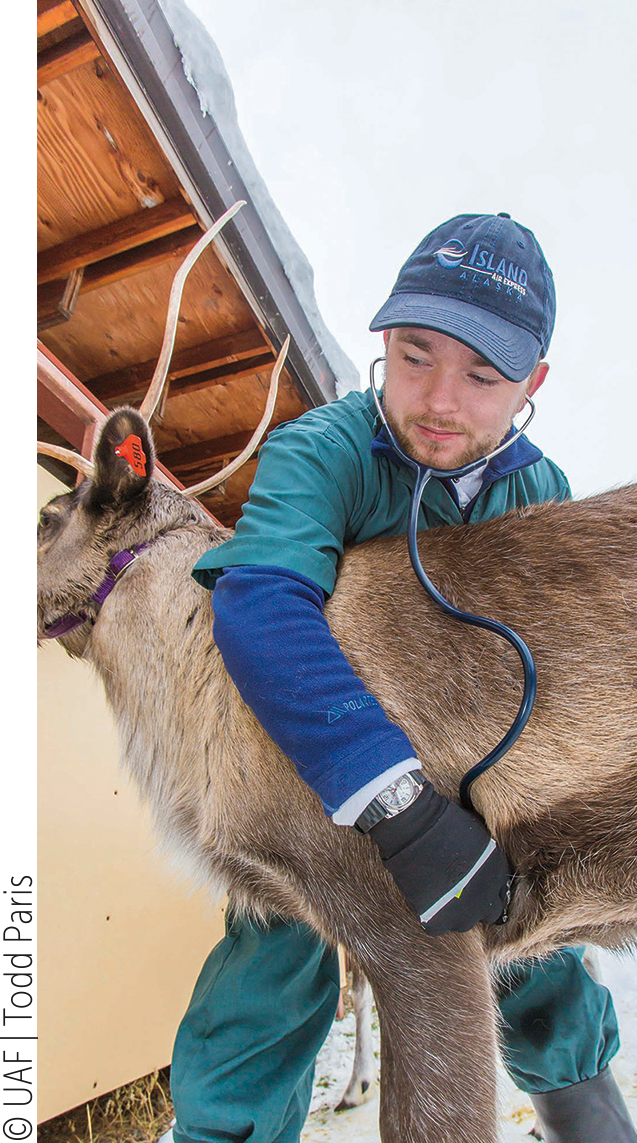
uaf.edu
The hotel’s new guest room design celebrates the up-to-date and accessible feeling of Hilton hotels. The natural color palette of earth and water tones highlights the beautiful colors of Alaska’s pristine wilderness and Northern Lights with a modern and comfortable atmosphere. columbiasussex.com
Business Events
nwaaae.site-ym.com/page/NWAAAEannual
Ketchikan: The conference includes training, workshops, lectures, and a firefighter competition. alaskafireconference.com
 Alaska Business is pleased to announce our newest staff addition, Monica Sterchi-Lowman; she joins us as our new Art Director. For the last ten years, Sterchi-Lowman owned and operated a boutique design studio, where she worked with organizations around the world. Through her experience with a broad spectrum of organizations, she found her passion for design that focuses on promoting education, youth, and community development.
Alaska Business is pleased to announce our newest staff addition, Monica Sterchi-Lowman; she joins us as our new Art Director. For the last ten years, Sterchi-Lowman owned and operated a boutique design studio, where she worked with organizations around the world. Through her experience with a broad spectrum of organizations, she found her passion for design that focuses on promoting education, youth, and community development.
A long-time supporter of the Anchorage community, Sterchi-Lowman has served on several nonprofit boards and was a founding member of AIGA Alaska, of which she currently serves as president. She is also a member of the Alaska Women’s Hall of Fame board and a past board member of the Zonta Yellow Rose Foundation.

 Nicole Licht was hired as Communications & Engagement Manager; she spent the last six years working for Procare Home Medical as their sales and marketing manager. Licht has twelve years of experience in healthcare sales and marketing in Alaska.
Nicole Licht was hired as Communications & Engagement Manager; she spent the last six years working for Procare Home Medical as their sales and marketing manager. Licht has twelve years of experience in healthcare sales and marketing in Alaska.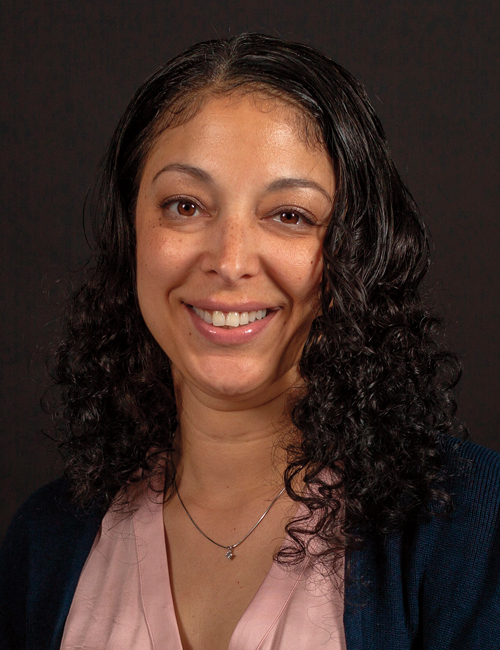
 Rachel Lawler has been hired as the Health IT Training Coordinator. Previously she was with Beacon Occupational Health and Safety Services for eight years where she was in charge of clinical operations. She has fourteen years of experience in healthcare.
Rachel Lawler has been hired as the Health IT Training Coordinator. Previously she was with Beacon Occupational Health and Safety Services for eight years where she was in charge of clinical operations. She has fourteen years of experience in healthcare.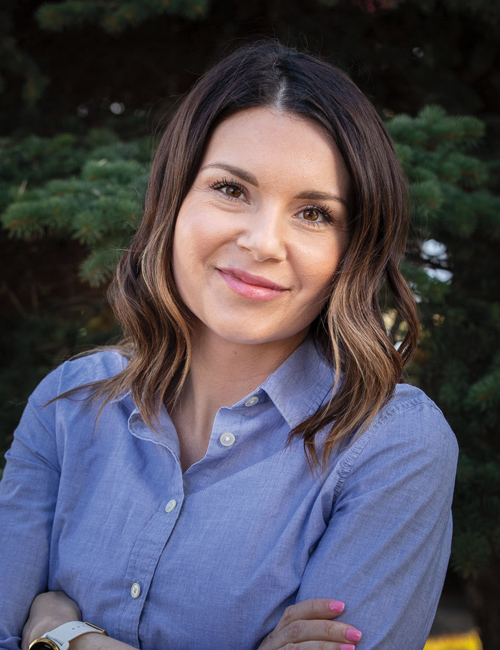
At a Glance
What book is on your nightstand?
The Looming Tower: Al Qaeda and the Road to 9/11 by Lawrence Wright, which is a look at how 9/11 happened; Sapiens: A Brief History of Humankind by Yuval Noah Harari, which is a complete history of the entire human species; and The Last Magician by Lisa Maxwell, a fantasy book that takes place in historic New York City.
What movie do you recommend to everyone?
Silence of the Lambs is one of my all-time favorite movies just because of how amazing the acting is. Going old school—Charade with Cary Grant and Audrey Hepburn
What’s the first thing you do after work?
I change out of my “work armor” clothes and into something I feel is more comfortable, and then I turn on some music.
If you couldn’t live in Alaska, where would you live?
If I didn’t have to worry about money, New York City, without a doubt.
If you could domesticate a wild animal, what animal would it be?
A bald eagle—it’s got nothing to do with being patriotic, they’re just beautiful birds and being able to get one to do my bidding would be pretty awesome.
At a Glance
What book is on your nightstand?
The Looming Tower: Al Qaeda and the Road to 9/11 by Lawrence Wright, which is a look at how 9/11 happened; Sapiens: A Brief History of Humankind by Yuval Noah Harari, which is a complete history of the entire human species; and The Last Magician by Lisa Maxwell, a fantasy book that takes place in historic New York City.
What movie do you recommend to everyone?
Silence of the Lambs is one of my all-time favorite movies just because of how amazing the acting is. Going old school—Charade with Cary Grant and Audrey Hepburn
What’s the first thing you do after work?
I change out of my “work armor” clothes and into something I feel is more comfortable, and then I turn on some music.
If you couldn’t live in Alaska, where would you live?
If I didn’t have to worry about money, New York City, without a doubt.
If you could domesticate a wild animal, what animal would it be?
A bald eagle—it’s got nothing to do with being patriotic, they’re just beautiful birds and being able to get one to do my bidding would be pretty awesome.
Off the Cuff
ason Hodges is the Executive Director of the Anchorage Concert Association, a role he’s been performing for more than eleven years. He focuses on expanding the reach of the Anchorage Concert Association, giving as many people as possible in the community exposure to the performing arts. He says his favorite part of the job is the end of a performance when the audience applauds: “While that applause is not for me—it’s for the artist on the stage—I take a moment to experience it and take a piece for myself because we were a small part in helping put the audience together with the artist to create that magic, that moment of community—and it’s a great moment.”
Alaska Business: What do you do in your free time?
Jason Hodges: For the last couple of years photography has been something I’ve been really passionate about. Cooking is another huge one.
AB: Is there a skill you’re currently developing or have always wanted to learn?
Hegna: There was a period of time right after college when I was taking piano lessons, but then the woman who was teaching the class wanted me to do a recital… and I just wanted to learn, so I kind of gave it up then. [Playing] piano is something I wish I’d done or could learn without having to find 10,000 hours to achieve mastery, as Malcolm Gladwell would say.


